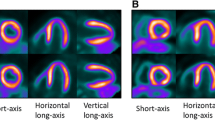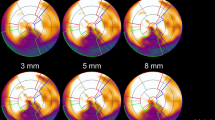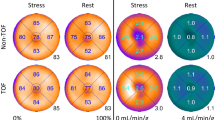Abstract
Background
The effect of time-of-flight (TOF) and point spread function (PSF) modeling in image reconstruction has not been well studied for cardiac PET. This study assesses their separate and combined influence on 82Rb myocardial perfusion imaging in obese patients.
Methods
Thirty-six obese patients underwent rest-stress 82Rb cardiac PET. Images were reconstructed with and without TOF and PSF modeling. Perfusion was quantitatively compared using the AHA 17-segment model for patients grouped by BMI, cross-sectional body area in the scanner field of view, gender, and left ventricular myocardial volume. Summed rest scores (SRS), summed stress scores (SSS), and summed difference scores (SDS) were compared.
Results
TOF improved polar map visual uniformity and increased septal wall perfusion by up to 10%. This increase was greater for larger patients, more evident for patients grouped by cross-sectional area than by BMI, and more prominent for females. PSF modeling increased perfusion by about 1.5% in all cardiac segments. TOF modeling generally decreased SRS and SSS with significant decreases between 2.4 and 3.0 (P < .05), which could affect risk stratification; SDS remained about the same. With PSF modeling, SRS, SSS, and SDS were largely unchanged.
Conclusion
TOF and PSF modeling affect regional and global perfusion, SRS, and SSS. Clinicians should consider these effects and gender-dependent differences when interpreting 82Rb perfusion studies.
Spanish Abstract
Antecedentes
El efecto de los algoritmos de reconstrucción “time of flight” (TOF) y “point spread function” (PSF) en la reconstrucción de imágenes no ha sido bien estudiado para el PET cardiaco. Este estudio evalúa su influencia en por separado y combinado en los estudios de imagen de perfusión miocárdica con 82Rb en pacientes obesos.
Métodos
Treinta y seis pacientes obesos fueron sometidos a un PET cardiaco 82Rb en estrés y en reposo. Las imágenes fueron reconstruidas con y sin TOF y PSF. La perfusión fue comparada cuantitativamente utilizando el modelo segmentario AHA17 para pacientes agrupados por IMC, área corporal transversal in el campo de vista del escáner, sexo y volumen ventricular izquierdo miocárdico. Los puntajes sumados de reposo (SRS), los puntajes sumados de estrés (SSS) y el puntaje diferencial sumado (SDS) fueron comparados.
Resultados
El TOF mejoró la uniformidad visual del mapa polar e incrementó la perfusión de la pared septal hasta un 10%. Este incremento fue mayor para pacientes más grandes, más evidentemente en pacientes agrupados por área transversal que por IMC, y siendo más prominente en mujeres. El PSF aumentó la perfusión por cerca de 1.5% en todos los segmentos cardiacos. El TOF generalmente disminuyó el SRS y el SSS con disminuciones significativas entre 2.4 y 3 (P < .05), lo cual podría afectar la estratificación por riesgo; el SDS permanece igual. Con el modelamiento PSF, el SRS, el SSS y el SDS no presentaron cambios.
Conclusión
El TOF y el PSF afecta a la perfusión regional y global, el SRS y el SSS. Los clínicos deberían considerar estos efectos y las diferencias dependientes de sexo cuando se interpretan los estudios de perfusión con 82Rb.
Chinese Abstract
背景
飞行时间(TOF)和点扩散函数(PSF)建模对于心脏 PET 成像重建的影响尚未完善建立。本研究评估其单独以及联合使用对肥胖病人行铷 82 心肌灌注成像的影响。
方法
36 个肥胖病人接受静息-负荷的铷 82 心脏 PET 成像扫描。图像分别在有无 TOF 和 PSF 建模的情况下被重建。病人按照 BMI、扫描仪视野下横断面的体表面积、性别和左室容积进行分组,采用 AHA 17节段模型量化对比灌注情况,比较静息灌注总积分(SRS),负荷灌注总积分(SSS)和灌注总积分差值(SDS)。
结果
TOF 改进了靶心图的视觉一致性, 间隔壁的灌注增加了10%。这种增加表现为: 体型越大的病人增加越大, 以横断面体表面积分组的病人比用 BMI 分组的病人增加更明显,女性比男性增加更突出。在所有的心脏节段中, PSF 建模增加了约 1.5% 的灌注。TOF 建模总体上显著降低了SRS和 SSS(在 2.4 和 3.0 之间, P < .05), 这会影响风险分层; SDS 保持不变。利用 PSF 建模, SRS, SSS 和 SDS 在很大程度上保持不变。
结论
TOF 和 PSF 建模影响局部和整体灌注、SRS 以及 SSS。当阅读铷 82 灌注图像时, 临床医生应该考虑这些因素的影响以及性别导致的不同。
French Abstract
Contexte
L’effet de la modélisation du temps de vol (TOF) et de la fonction d’étalement ponctuel (PSF) pour la reconstruction d’images n’a pas été bien étudiée pour la TEP en cardiologie. Cette étude évalue l’influence séparée et combinée des ces deux facteurs sur la perfusion myocardique par imagerie au 82Rb chez les patients obèses.
Méthodes
Trente-six patients obèses ont été soumis à une étude TEP repos-effort au 82Rb au repos. Les images ont été reconstruites avec et sans modélisation TOF et PSF. Les résultats de la perfusion myocardique a été comparée quantitativement en utilisant le modèle de 17 segments de l’American Heart Association (AHA). Les patients ont été groupés selon l’index de leur masse corporelle (IMC), et selon leur dimension corporelle transversale dans le champ de vision du scanner, sexe et volume myocardique ventriculaire gauche. Les score de perfusion myocardique au repos (SRS), après effort (SSS) et les scores différentiels (SDS) ont été comparés.
Résultats
TOF améliore l’uniformité visuelle de la carte polaire et augmente la perfusion de la paroi septale de 10%. Cette augmentation est plus importante chez les patients de grande taille et plus apparente chez les patients groupés selon leur dimension corporelle transversale zone plutôt que par l’IMC, et plus élevée chez les femmes. La modélisation PSF augmente la perfusion d’environ 1,5% dans tous les segments cardiaques. La modélisation TOF diminue significativement les scores SRS et le SSS de 2,4 et 3,0 points (P < 0,05), ce qui peut changer la stratification; le score SDS est dans l’ensemble inchangé. Avec la modélisation PSF, SRS, SSS et SDS sont largement inchangés.
Conclusion
La modélisation TOF et PSF affectent la perfusion régionale et globale, SRS et SSS. Les cliniciens devraient tenir compte de ces effets et des différences entre les sexes lors de l’interprétation 82Rb études de perfusion.








Similar content being viewed by others
Abbreviations
- BMI:
-
Body mass index
- CAD:
-
Coronary artery disease
- FWHM:
-
Full-width at half-maximum
- FOV:
-
Field of view
- LMM:
-
Linear mixed effects model
- LV:
-
Left ventricular/left ventricle
- MPI:
-
Myocardial perfusion imaging
- OSEM:
-
Ordered subsets expectation maximization
- OSEMTOF:
-
OSEM reconstruction with TOF modeling
- PET:
-
Positron emission tomography
- PSF:
-
Point spread function/OSEM reconstruction with PSF modeling
- PSFTOF:
-
OSEM reconstruction with TOF and PSF modeling
- SDS:
-
Summed difference score
- SNR:
-
Signal-to-noise ratio
- SPECT:
-
Single-photon emission computed tomography
- SRS:
-
Summed rest score
- SSS:
-
Summed stress score
- TOF:
-
Time-of-flight
References
Bateman TM, Heller GV, McGhie AI, Friedman JD, Case JA, Bryngelson JR, et al. Diagnostic accuracy of rest/stress ECG-gated Rb-82 myocardial perfusion PET: Comparison with ECG-gated Tc-99m sestamibi SPECT. J Nucl Cardiol. 2006;13:24–33.
Flotats A, Bravo PE, Fukushima K, Chaudhry MA, Merrill J, Bengel FM. 82Rb PET myocardial perfusion imaging is superior to 99mTc-labelled agent SPECT in patients with known or suspected coronary artery disease. Eur J Nucl Med Mol I. 2012;39:1233–9.
Sampson UK, Dorbala S, Limaye A, Kwong R, Di Carli MF. Diagnostic accuracy of rubidium-82 myocardial perfusion imaging with hybrid positron emission tomography/computed tomography in the detection of coronary artery disease. J Am Coll Cardiol. 2007;49:1052–8.
Freedman N, Schechter D, Klein M, Marciano R, Rozenman Y, Chisin R. SPECT attenuation artifacts in normal and overweight persons: Insights from a retrospective comparison of Rb-82 positron emission tomography and Tl-201 SPECT myocardial perfusion imaging. Clin Nucl Med. 2000;25:1019–23.
Mc Ardle BA, Dowsley TF, deKemp RA, Wells GA, Beanlands RS. Does rubidium-82 PET have superior accuracy to SPECT perfusion imaging for the diagnosis of obstructive coronary disease? A systematic review and meta-analysis. J Am Coll Cardiol. 2012;60:1828–37.
Chow BJW, Dorbala S, Di Carli MF, Merhige ME, Williams BA, Veledar E, et al. Prognostic value of PET myocardial perfusion imaging in obese patients. J Am Coll Cardiol Img. 2014;7:278–87.
Karp JS, Surti S, Daube-Witherspoon ME, Muehllehner G. Benefit of time-of-flight in PET: Experimental and clinical results. J Nucl Med. 2008;49:462–70.
Conti M. Focus on time-of-flight PET: The benefits of improved time resolution. Eur J Nucl Med Mol I. 2011;38:1147–57.
Lois C, Jakoby BW, Long MJ, Hubner KF, Barker DW, Casey ME, et al. An assessment of the impact of incorporating time-of-flight Information into clinical PET/CT imaging. J Nucl Med. 2010;51:237–45.
Taniguchi T, Akamatsu G, Kasahara Y, Mitsumoto K, Baba S, Tsutsui Y, et al. Improvement in PET/CT image quality in overweight patients with PSF and TOF. Ann Nucl Med. 2015;29:71–7.
Kadrmas DJ, Casey ME, Conti M, Jakoby BW, Lois C, Townsend DW. Impact of time-of-flight on PET tumor detection. J Nucl Med. 2009;50:1315–23.
Daube-Witherspoon ME, Surti S, Perkins AE, Karp JS. Determination of accuracy and precision of lesion uptake measurements in human subjects with time-of-flight PET. J Nucl Med. 2014;55:602–7.
Conti M. Why is TOF PET reconstruction a more robust method in the presence of inconsistent data? Phys Med Biol. 2011;56:155–68.
Turkington TG, Wilson JM. Attenuation artifacts and time-of-flight PET. 2009 IEEE Nuclear Science Symposium Conference Record, Vols 1-5. 2009:2997-9.
Bai C, Andreyev A, Hu Z, Maniawski P, Zhang J, Knopp M. TOF reconstruction for improved quantitative accuracy in PET/CT studies with misalignment. J Nucl Med. 2016;57:478.
Panin VY, Kehren F, Michel C, Casey M. Fully 3-D PET reconstruction with system matrix derived from point source measurements. IEEE Trans Med Imaging. 2006;25:907–21.
Walker MD, Asselin MC, Julyan PJ, Feldmann M, Talbot PS, Jones T, et al. Bias in iterative reconstruction of low-statistics PET data: Benefits of a resolution model. Phys Med Biol. 2011;56:931.
Tong S, Alessio AM, Kinahan PE. Noise and signal properties in PSF-based fully 3D PET image reconstruction: An experimental evaluation. Phys Med Biol. 2010;55:1453.
Rahmim A, Qi J, Sossi V. Resolution modeling in PET imaging: Theory, practice, benefits, and pitfalls. Med Phys. 2013;40:064301.
Tong S, Alessio AM, Thielemans K, Stearns C, Ross S, Kinahan PE. Properties and mitigation of edge artifacts in PSF-based PET reconstruction. IEEE Trans Nucl Sci. 2011;58:2264–75.
Le Meunier L, Slomka PJ, Dey D, Ramesh A, Thomson LEJ, Hayes SW, et al. Enhanced definition PET for cardiac imaging. J Nucl Cardiol. 2010;17:414–26.
Armstrong IS, Tonge CM, Arumugam P. Impact of point spread function modeling and time-of-flight on myocardial blood flow and myocardial flow reserve measurements for rubidium-82 cardiac PET. J Nucl Cardiol. 2014;21:467–74.
DiFilippo FP, Brunken RC. Impact of time-of-flight reconstruction on cardiac PET images of obese patients. Clin Nucl Med. 2017;42:e103–8.
Tipnis S, Hu Z, Gagnon D, O’ Donnell J. Time-of-flight PET for Rb-82 cardiac perfusion imaging. J Nucl Med. 2008;49:74P.
Oldan JD, Shah SN, Brunken RC, DiFilippo FP, Obuchowski NA, Bolen MA. Do myocardial PET-MR and PET-CT FDG images provide comparable information? J Nucl Cardiol. 2016;23:1102–9.
Armstrong IS, Tonge CM, Arumugam P. Assessing time-of-flight signal-to-noise ratio gains within the myocardium and subsequent reductions in administered activity in cardiac PET studies. J Nucl Cardiol 2017.
Wells RG, deKemp RA. Does time-of-flight improve image quality in the heart? J Nucl Cardiol 2017.
Budinger TF. Time-of-flight positron emission tomography: Status relative to conventional PET. J Nucl Med. 1983;24:73–8.
Dasari PKR, Jones JP, Casey ME, Smith MF. The effect of time-of-flight and point spread function modeling on quantitative cardiac PET of large patients: Phantom studies. IEEE Trans Rad Plasma Med Sci. 2017;1:416–25.
Jakoby BW, Bercier Y, Conti M, Casey ME, Bendriem B, Townsend DW. Physical and clinical performance of the mCT time-of-flight PET/CT scanner. Phys Med Biol. 2011;56:2375–89.
Tout D, Tonge CM, Muthu S, Arumugam P. Assessment of a protocol for routine simultaneous myocardial blood flow measurement and standard myocardial perfusion imaging with rubidium-82 on a high count rate positron emission tomography system. Nucl Med Commun. 2012;33:1202–11.
Watson CC. Extension of single scatter simulation to scatter correction of time-of-flight PET. IEEE Trans Nucl Sci. 2007;54:1679–86.
Esteves FP, Nye JA, Khan A, Folks RD, Halkar RK, Garcia EV, et al. Prompt-gamma compensation in Rb-82 myocardial perfusion 3D PET/CT. J Nucl Cardiol. 2010;17:247–53.
Cerqueira MD, Weissman NJ, Dilsizian V, Jacobs AK, Kaul S, Laskey WK, et al. Standardized myocardial segmentation and nomenclature for tomographic imaging of the heart: A statement for healthcare professionals from the Cardiac Imaging Committee of the Council on Clinical Cardiology of the American Heart Association. Circulation. 2002;105:539–42.
Ficaro EP, Lee BC, Kritzman JN, Corbett JR. Corridor4DM: The Michigan method for quantitative nuclear cardiology. J Nucl Cardiol. 2007;14:455–65.
Hachamovitch R, Berman D, Shaw LJ, Germano G, Mieres JH. Risk stratification and patient management. In: Dilsizian V, Narula J, editors. Atlas of nuclear cardiology. 4th ed. New York: Springer; 2013. p. 247–88.
Germano G, Kavanagh P, Waechter P, Areeda J, Van Kriekinge S, Sharir T, et al. A new algorithm for the quantitation of myocardial perfusion SPECT. I: Technical principles and reproducibility. J Nucl Med. 2000;41:712–9.
Wawrzyniak A, Dilsizian V, Krantz D, Harris K, Smith M, Shankovich A, et al. High concordance between mental stress-induced and adenosine-induced myocardial ischemia assessed using SPECT in heart failure patients: Hemodynamic and biomarker correlates. J Nucl Med. 2015;56:1527–33.
Disclosure
This work was supported in part by Siemens Medical Solutions. P.K.R. Dasari, V. Dilsizian, M.F. Smith, and Y. Liang were employees of the University of Maryland, Baltimore when this research was conducted. J.P. Jones and M.E. Casey were employees of Siemens Healthineers.
Author information
Authors and Affiliations
Corresponding author
Additional information
The authors of this article have provided a PowerPoint file, available for download at SpringerLink, which summarises the contents of the paper and is free for re-use at meetings and presentations. Search for the article DOI on SpringerLink.com.
JNC thanks Erick Alexanderson MD, Carlos Guitar MD, and Diego Vences MD, UNAM, Mexico, for providing the Spanish abstract; Haipeng Tang MS, Zhixin Jiang MD, and Weihua Zhou PhD, for providing the Chinese abstract; and Jean-Luc Urbain, MD, PhD, CPE, Past President CANM, Chief Nuclear Medicine, Lebanon VAMC, PA, for providing the French abstract.
Electronic supplementary material
Below is the link to the electronic supplementary material.
Rights and permissions
About this article
Cite this article
Dasari, P.K.R., Jones, J.P., Casey, M.E. et al. The effect of time-of-flight and point spread function modeling on 82Rb myocardial perfusion imaging of obese patients. J. Nucl. Cardiol. 25, 1521–1545 (2018). https://doi.org/10.1007/s12350-018-1311-y
Received:
Accepted:
Published:
Issue Date:
DOI: https://doi.org/10.1007/s12350-018-1311-y




